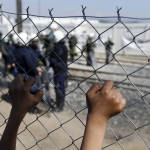Bainbridge resident says photos of refugee camp don’t ‘do it justice’
Mar 28, 2016, 5:35 PM | Updated: Jul 8, 2022, 12:24 pm

According to the International Rescue Committee, Moayad and his six-month-old daughter, Zehraa, are trying to join the rest of their family in Sweden. They were separated in Turkey. "The baby is crying so much," he tells the IRC. "She needs her mother. It's been so difficult." (Jodi Hilton/International Rescue Committee)
(Jodi Hilton/International Rescue Committee)
With a population that has swelled to as many as 15,000, the makeshift refugee camp near the Greek village of Idomeni is now home to one of the worst humanitarian crises in the world. Madi Williamson, a 21-year-old Bainbridge Island resident, says it’s mind-blowing.
“It’s honestly something that television, writing, photographs … it doesn’t do it justice,” she said. “Just the combination of the smells, the sounds, the vastness of looking through the smog and seeing one-and-a-half football fields worth of tents that people are living in and burning toxic fires. It’s unbelievable.”
The burn fires are to stay warm and to cook their food. Fuel for the fires includes clothing, plastic containers, and cardboard.
Related: Refugee, immigration controversy has long history in Washington
The people living in this camp are Syrian refugees fleeing war and asylum-seekers from other countries, such as Afghanistan, Iraq and as far away as the Democratic Republic of Congo.
Williamson is on a medical mission with a small Seattle NGO, called Salaam Cultural Museum.
“My job is to stand at the back of van and doctors will assess patients and tell me what they need and so I’m kind of working as our little pharmacist,” she said. “I know what we have and what we don’t have. I know where everything is. I keep a running list of what need to restock in the van at the end of the day.”
She’s face-to-face with the plight of stranded families, whose stories will stay with her. They’re people she wishes she could do more for, like one woman who came looking for help for her baby.
“She asked for formula. We’re like, ‘we don’t have it.’ She looked distraught. She said, ‘I can’t find any!'”
Another man showed up delirious with pain. “We had a guy here who has some dental experience who looked at him and said, ‘That’s a molar. I can give you something for pain but, A, we’re not dentists and, B, that’s going to require some pretty serious surgery.’ The man then got pliers and threatened to pull it out in front of us,” Williamson explained.
She says they need dentists. She says lactation consultations would be useful, too, because there is a shortage of baby formula and no way to sterilize baby bottles.
The bigger NGOs undertake large projects, like setting up tents, handing out bottled water, and building places for people to go to the bathroom.
A million asylum-seekers arrived in Europe in 2015. About 800,000 of them went to Greece.
European Union leaders have been working with Turkey to come up with a deal to curb the influx of migrants, who flee hardship but may not meet requirements for refugee status. A new agreement, instituted on March 20, would send some refugees and migrants back to Turkey. In exchange, 28 EU nations would take in 72,000 Syrian refugees.
The United Nation and many other aid groups, like the International Rescue Committee, protest the deal, saying it goes against international law and forces refugees into prison-like detention centers.
Mireille Cronin Mather with the IRC says these asylum-seekers, including the ones at Idomeni, are now left with very little options.
“We’ve had a lot of questions about the security and vetting of refugees that are … allowed to come to the United States by the U.S. government,” she said. “What we say is that the atrocities that happened in Brussels last week and in Paris mirror the atrocities that refugees are fleeing in Syria.”
Responding to American lawmakers who mistrust the resettlement system, she says refugees go through rigorous background checks.
“We know from having resettled refugees in the U.S. since World War II, that essentially, refugees are the most vetted people who come to the United States,” Cronin Mather said.
“There’s a multi-step process, up to 15 steps now, that involves many different elements of the United States government, from DHS to FBI to the Department of Defense and many other intelligence agencies. Refugees are interviewed, questioned, and given background checks before they’re ever allowed to set foot in the U.S.
“They are not the terrorists,” Mather added. “They are people who are fleeing terrorism.”
About 10,000 Syrian refugees will be allowed to be resettled in the United States in 2016. Last year, 25 Syrians resettled in Washington state.
Madi Williamson will return home in a few days. She wishes the U.S. would take more Syrian refugees.
“These people are no different than us,” she said. “They’re educated. And they just want a safe place to be.”
Williamson has met people who back home were pharmacists, nurses, tour guides, engineers, schoolteachers.
“It’s pretty sobering,” she said.
But the good moments keep her going. For example, the young mother she helped as the woman was going into labor, feverish and terrified. Williamson didn’t know how it turned out after she sent the woman off in a Greek ambulance.
But the next day, they saw each other in the camp.
“She came over and shook my hand,” Williamson described. “And I don’t speak Arabic. I wasn’t able to say much to her, but just looking in someone’s eyes and knowing they appreciate you and you appreciate them and you’re happy to see each other, even if you can’t speak a word to each other, is a pretty cool thing.”
























